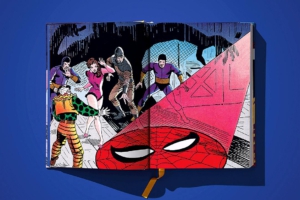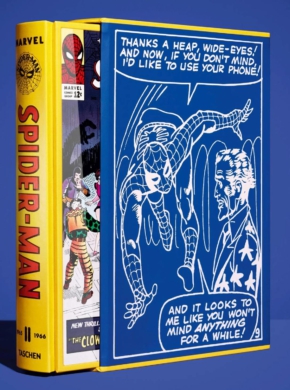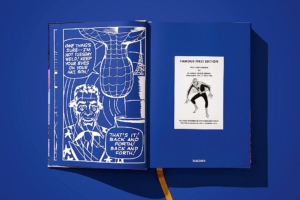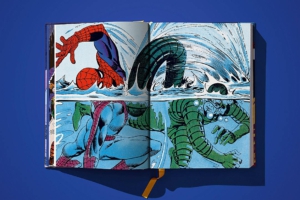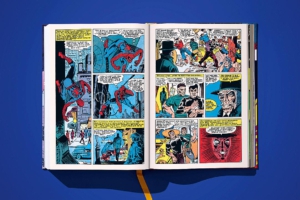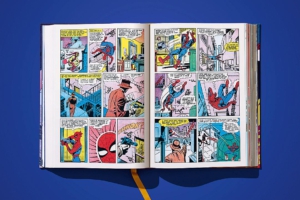The latest addition to Taschen’s XXL Marvel Comic Library has the focus on the later adventures of Peter Parker, better known as Spider-Man, in New York City. And what action awaits there!
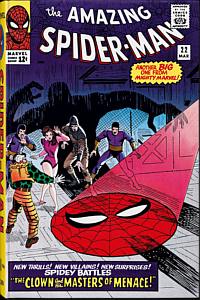 In the years 1965 and 1966, the extremely successful collaboration of Marvel’s mastermind Stan Lee (script and editor) and legendary Steve Ditko (drawings, ink, penciling) who invented the character continued and got better, so fans would agree, with every issue.
In the years 1965 and 1966, the extremely successful collaboration of Marvel’s mastermind Stan Lee (script and editor) and legendary Steve Ditko (drawings, ink, penciling) who invented the character continued and got better, so fans would agree, with every issue.
Readers can easily check that, as all volumes #20 to #38 (and king size Annual No. 2) of The Amazing Spider-Man are ready for inspection now, as usual in perfect reproduction quality, vintage colors and on authentic rough, pulpy paper, but in XXL page size.
The originals of the scans, that were digitally remastered using modern retouching techniques to straighten out layout and printing problems of the era’s imperfect printing technology, come from the collection of Bob Bretall, he is the holder of the Guinness World Record for the largest comics collection.
To ensure quality and authenticity, the reproductions are the result of close collaboration between Marvel and the Certified Guaranty Company. Again, there are two versions of this heavy book in English only, the Edition of 1,000 (1,000 pieces) and the Famous First Edition (5,000 pieces).
In the volumes here, Spidey meets Kraven the Hunter, Molten Man, Scorpion, Mysterio, the Green Goblin and besides more villains, well, another “challenge,” as he has very uneasy encounters with his first girlfriend, Betty Brant.
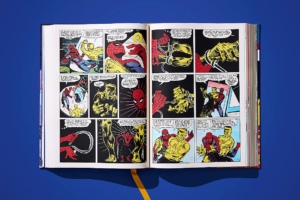 Although we watch Peter grow a bit older, get more skilled in battles and breathtaking skyscraper dives, he still has a lot of the inexperienced teenager, who would be clueless and taken off-balance easily, as soon as would-be girlfriends entered the scene. By the way, his other interest “MJ” Mary Jane Watson, also appears during this second Lee/Ditko installment.
Although we watch Peter grow a bit older, get more skilled in battles and breathtaking skyscraper dives, he still has a lot of the inexperienced teenager, who would be clueless and taken off-balance easily, as soon as would-be girlfriends entered the scene. By the way, his other interest “MJ” Mary Jane Watson, also appears during this second Lee/Ditko installment.
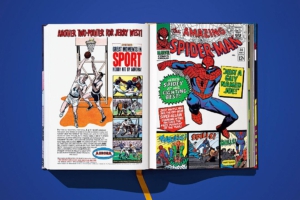 The fact that Peter finished high school and now attends college and struggles with jobs to stay alive, kept Spider-Man fans interested. Peter hates his job at the paper Bugle, but desperately needs it. And such new experiences either already were part of Spidey’s readership, or were about to happen soon. (Which still in volume two of Spider-Man lore is probably the one thing that made Peter Parker – super powers or not – so sympathetic and realistic.)
The fact that Peter finished high school and now attends college and struggles with jobs to stay alive, kept Spider-Man fans interested. Peter hates his job at the paper Bugle, but desperately needs it. And such new experiences either already were part of Spidey’s readership, or were about to happen soon. (Which still in volume two of Spider-Man lore is probably the one thing that made Peter Parker – super powers or not – so sympathetic and realistic.)
The long introduction of this volume comes from acclaimed British TV and radio host, popular culture expert and comic book fan Jonathan Ross. He is the author of the revered BBC documentary “In Search of Steve Ditko” (2007).
The thirty pages on which he enlarges on the artist, Stan Lee, letterers Artie Simerk, Sam Rosen, Marvel Comics and Peter’s maturation and his adventures set in the American 1960s, overflowing with societal upheavals are extravagantly supported by memorabilia, cover sketches, photographs and other rarities associated with “your friendly neighborhood Spider-Man.”
Ross explains all the extras, plots, and sometimes very dynamic stories that often were roughly conceived by Stan Lee, but finalized and carried out in detail by Steve Ditko of every issue the volume holds. His splash panels are legendary and usually find Spidey fighting one or several arch enemies, and hardly a spot in those screens is motionless.
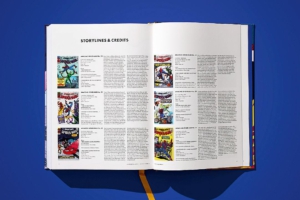 Ross quotes Steve Dikto’s approach to diverse situations or settings and Spidey’s reactions: “I prefer conflicts that are based on reality rather than based on fantasy. When you get wound up with super villains, super fantastic gadgets and super incredible action, everything has to be made so deliberately that it all becomes senseless. It boils down to what you want a story to stand for. Every person, whether he wants to be or not, is in a continuous struggle. It is a struggle to keep his mind from being corrupted.”
Ross quotes Steve Dikto’s approach to diverse situations or settings and Spidey’s reactions: “I prefer conflicts that are based on reality rather than based on fantasy. When you get wound up with super villains, super fantastic gadgets and super incredible action, everything has to be made so deliberately that it all becomes senseless. It boils down to what you want a story to stand for. Every person, whether he wants to be or not, is in a continuous struggle. It is a struggle to keep his mind from being corrupted.”
Apart from being “classic” Spider-Man artwork, this volume of the Taschen series includes the three-part (or even four-part) so-called “Master Planner Saga.” The chronicle lasted from #30 to #33, and at the time of publication in 1965, it actually was Spidey’s longest connected adventure and for comic book standards of the day an incredibly long story. Super villain “Master Planner” (or “Doc Ock,” as he would be properly named later), on more than the usual twenty or thirty pages endeavored to destroy Spidey, but it should be clear who would win that match.
Spider-Man, the character and the idea behind it, would be a success-story that lasted for decades. Looking back on the unique Lee/Ditko team work at Marvel, Ross is certain that the comics had a lasting effect on many readers and future comic book artists alike in the years to come, as ” … their incredible if brief partnership gave us these masterpieces to cherish and enjoy. Remarkable though it may seem, it’s not an overstatement to say that together, they changed the world.”
As expected, this XXL Marvel Comics Library hardcover title again will excite comic book fans, as it leaves no room for complaints. Although Spider-Man was continued by other artists (among them a fantastic John Romita, sr.) and in other settings, Steve Ditko’s vision of the insecure superhero is probably the best presentation.
Review by Dr. A. Ebert © 2024
Stan Lee and Jonathan Ross (eds.) Marvel Comics Library. Spider-Man. Vol. 2. 1965–1966. Famous First Edition. Taschen, 2023, First printing of 5,000 numbered copies, 11.0 x 15.6 in., 9.71 lb, 626 p., ISBN 978-3-8365-9652-7
Stan Lee and Jonathan Ross (eds.) Marvel Comics Library. Spider-Man. Vol. 2. 1965–1966. Edition of 1,000. Taschen, 2023, Aluminum print cover tipped into a leatherette-bound spine, foil embossing, and housed in a slipcase, 11.0 x 15.6 in., 10.24 lb, 626 p., ISBN 978-3-8365-9222-2

